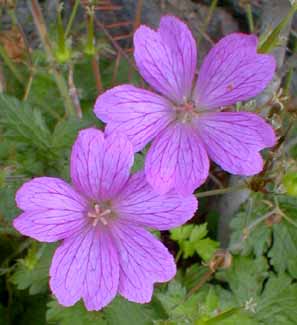 Iberian Crane's-bill; or,
Iberian Crane's-bill; or,
Caucasus Hardy Geranium
"Midnight shakes the memory
As a madman shakes a dead geranium."
-T. S. Elliot
(1888‚1965)
(1888‚1965)
The natural range of Geranium ibericum ssp ibericum (formerly G. nepalense var. thunbergii) is from the Caucausus mountains to Iran & Northeast Turkey. The species name insinuates it is from Iberia (Spain), though this is untrue. Its region of the Caucausus is primarily in Georgia, but this crane's-bill's region was once known as Caucasian Iberia because in the early Dark Ages the main passes through these mountains were controlled by Iberia.
The species self-seeds aggressively. It has escaped gardens to naturalize in a few American states, especially in the Northeast & Colorado.
Several years ago, this crane's-bill geranium came to us as a "volunteer" stowing away at the foot of a newly installed Royal Star Magnolia. As the Royal Star is a rather common shrub (or small tree), we've felt its crane's-bill companion lends it a needed distinction.
When the magnolia is done blooming early in spring, it's the crane's-bill's turn to keep the larger shrub sprinkled with blossoms, which it does throughout the year, sometimes still blooming as late as November. The Royal Star Magnolia will periodically produce an extra white flower or two later in the year, well after its primary bloom period very early in spring. These occasional flowers look swell among all the numerous blooms which the crane's-bill weaves throughout the shrub.
It thrives in full sun or partial shade. An old clump is quite drought-hardy, though if not well watered during a hot summer it will get very scruffy & need to be cut back, after which it will make a dramatic recovery for autumn.
Any time it doesn't look its finest it should just be cut back to start over. Its recovery is almost instantaneous & it can look very appealing most of the year. It will grow more rapidly in rich humusy soil & in consequence need to be shorn a few times each year, but in poor light soil it needs less attention while looking just as great.
This remarkable beauty has been used in the development of some of the most famous & finest cultivars, including especially G. x magnificum which intensifies the blue & has even larger flowers. Such hybrid cultivars are generally to be preferred, as they are more restrained, commonly sterile, so will not be so weedy. But it's no great burden to weed out seedlings that erupt in unexpected locations. They also transplant well so that several of the offspring of the initial clump have been moved to places like the alley, where they are reliably beautiful in the harshest locations. The Iberian crane's-bill has frankly become one of my favorites for peripheral gardens that are more difficult to water regularly.
It's large leafy presence completely overwhelms weeds, so is an ideal clumping groundcover for low-maintenance gardens. A mature clump heaps itself upward to two feet or higher with even wider spread. Liking life at the dripline of large shrubs, it will frequently climb three feet into shrubs. They are more inclined to climb when planted in shady spots, more compactly clumping in full sun.
No later than Mayh, the large somewhat furry leaves become heavily dotted blooms that range from big lavender-pink to violet-blue, with darker purply-blue veins. In our temperate Zone 8 there is reflowering persistant until October or even later, though it can be grown down to the much chillier Zone 5 where it would be primarily as a summer-flowering perennial. It mostly dies back in winter & whatever is left of it by winter's end needs to be clipped, & it starts over with extreme rapidity.